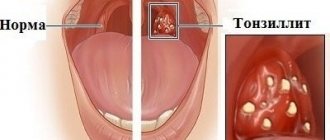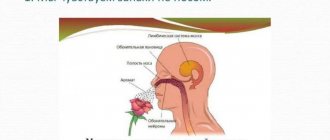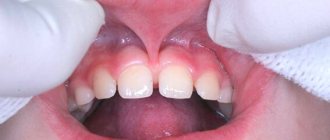Candida is a yeast fungus that is constantly found on the mucous membrane of the gastrointestinal tract and oral cavity. As a result of stressful situations or taking medications, the balance of microflora becomes unstable. This leads to uncontrolled growth of the fungus and the appearance of thrush in the mouth.
Read on to find out what symptoms it is accompanied by and how to cure the disease in adults.
Causes of thrush in the mouth
Oral candidiasis is a common disease.
Very often a person does not even suspect that he is a carrier of Candida fungus. Its rapid reproduction occurs under the influence of several factors:
- long-term use of antibiotics, cytostatics or glucocorticosteroids;
- vitamin deficiency or hypovitaminosis, lack of iron in the body;
- impaired carbohydrate or fat metabolism;
- diabetes mellitus, problems with the thyroid gland, ovarian function;
- diseases of the gastrointestinal tract, genitourinary or reproductive systems in a chronic form;
- malignant neoplasms, AIDS;
- mechanical damage to the soft tissue of the gums;
- caries, impaired salivation, cyst, periodontitis;
- lack of regular cleaning of acrylic dentures;
- alcoholic beverages, tobacco products; bad ecology;
- frequent stress, overwork.
Reference! Oral thrush cannot appear on its own. It is a consequence of a violation or weakening of the body’s protective properties.
More information about the disease:
How does the disease manifest itself?
Candidiasis has several varieties, which differ from each other in course and etiology. But they have one common feature - a creamy-white plaque in the mouth.
Loose and dense spots are localized on the tonsils, tongue, and inner surface of the cheeks.
An easy way to identify candida at home:
Types of candidiasis and their symptoms
| Form of the disease | Symptoms |
| Acute pseudomembranous |
|
| Acute atrophic |
|
| Chronic hyperplastic |
|
| Chronic atrophic |
|
All types of candidal thrush in adults are accompanied by the appearance of a metallic taste, sometimes the temperature may rise or intoxication of the body may begin. The patient complains of poor health and fatigue.
Attention! Chronic candidiasis worsens with any infectious diseases or decreased immunity. It can affect not only the oral cavity, but also the esophagus.
Diagnosis of the disease
Identifying thrush begins with taking an oral history of the patient.
He must tell the dentist in detail when the first signs appeared, what worries him, and whether there are concomitant diseases. After examining the oral cavity, the patient is sent for a general blood test to determine glucose levels. Microscopic examination of the oral mucosa and biochemistry are carried out to confirm the causative agent of the disease. To do this, a scraping is taken from the surface of the tongue. It is not recommended to eat or brush your teeth for about three hours before the procedure.
Diagnosis should be aimed at identifying the cause that provoked the disease. Only in this case can you correctly draw up a treatment plan. In this case, if necessary, the patient may be referred for consultation to an endocrinologist or dermatologist.
Which doctor treats candidiasis:
Treatment
Treatment for thrush in the mouth should be carried out comprehensively and consistently.
First of all, drugs are prescribed that can fight the fungus. The patient needs to increase immunity and get rid of dysbacteriosis.
A dermatovenerologist on the treatment of oral thrush in adults and children:
General medications
In the early stages of the disease, therapy consists of taking lozenges:
- Diflucan is taken for fungal infections not only of the skin and mucous membranes, but also of internal organs. The dosage of the drug should not exceed one capsule per day. After about a day, you can notice a decrease in the symptoms of the disease. If thrush is a consequence of reduced immunity, Diflucan can be taken for a month as a preventative measure.
- Levorin or Nystatin is taken four times a day after each meal. The course of treatment is approximately two weeks. On the fifth day of treatment, you can notice a decrease in white plaque in the oral cavity, healing of wounds and cracks in the mucous membrane.
- Flucanazole is characterized by bioavailability and high efficiency. In addition, the drug has no contraindications: it can be taken by pregnant women and children after five years of age. Take two tablets a day for two weeks.
Diflucan
Levorin
Fluconazole
Important! Only the attending physician should prescribe medications after a complete examination and identification of the causes. Any drug can cause an allergic reaction, so the patient should be under the supervision of specialists.
Local preparations
At any stage of candidiasis, gels, ointments and rinses are effective. This is due to the fact that the drugs have a direct effect on the affected areas of the oral cavity.
- The Candide solution has no restrictions on its use. It has a destructive effect on the synthesis of estrogen, which is part of the fungal membrane. A cotton swab is soaked in the solution and the affected areas of the oral mucosa are treated. The procedure must be carried out at least three times a day.
- Miconazole is rubbed into the affected areas twice a day. The course of treatment sometimes lasts up to six weeks. This is influenced by the severity of the disease and symptoms.
- Using brilliant green, Lugol's is used to treat the mucous membrane several times a day. Furacilin solution is used to remove curd deposits. To do this, soak a cotton pad with it and wipe the surface of the cheeks and tongue.
Candide Miconazole Lugol's solution Furacilin
Antifungal ointments and solutions have become very popular. Unlike tablets, they have an effect on the fungus in a short time. In addition, they are not capable of causing harm to internal organs.
How to treat thrush in men and women:
Folk recipes
Traditional medicine has a positive effect on fungal infections, but only when combined with medications:
- Pour dried calendula flowers with a glass of boiling water for an hour. The decoction is taken every day for a week instead of tea. Within two days, the swelling will subside, and the area affected by the plaque will decrease.
- Chop the head of garlic and treat the affected areas with the resulting pulp three times a day. In addition, you can additionally include one clove in your daily diet.
- Cranberry or carrot juices have an antibacterial effect. Every day you need to drink ½ glass for about a month. If necessary, you can additionally wipe the oral mucosa.
- A cotton pad is soaked in aloe, rosehip or sea buckthorn oil. The compress is applied for twenty minutes daily.
- To treat thrush in the mouth, you can use natural honey. Before the procedure, carefully remove plaque with gauze soaked in soda solution. After this, a teaspoon of the product is kept in the mouth until completely absorbed.
How to treat candidiasis in the mouth -
The article is for informational purposes only, and we urge you not to self-medicate, despite the fact that some antifungal drugs are still available over the counter. You need to start with a microbiological study, and also a test for HIV infection.
Microbiological test - before starting to take antifungal drugs, it is very important to perform a microbiological test (culture of material from your oral cavity - identifying the amount of Candida, as well as determining the sensitivity of Candida to the main antifungal drugs). Please note that the analysis must include not only sensitivity to drugs, but also the number of Candida fungi.
The latter will make it possible to distinguish acute or chronic fungal infection from a banal carriage and, thus, confirm the diagnosis. Different laboratories may use different methods to determine antifungal susceptibility. The cheapest and most inaccurate is a Russian-made test that determines sensitivity to 6 antifungal drugs using the disk diffusion method (using disks produced by the Scientific Research Center for Physics, Russia). It is best if sensitivity to drugs is analyzed on a VITEK analyzer, France.
Treatment of oral candidiasis takes an average of 12-15 days (until the symptoms of the disease completely disappear). However, in patients with chronic candidiasis who have already had repeated relapses, maintenance courses of therapy will also be required. In case of a widespread process, treatment of the disease should be carried out by a dentist - in collaboration with doctors of other specialties (general practitioner, gynecologist, mycologist).
1) Local treatment for mild primary form of the disease -
Abroad, there are a large number of drugs for the treatment of mild forms of oral candidiasis, intended for local use in the oral cavity. These are special mucoadhesive tablets with Miconazole 50 mg, which are taken only once a day. These are lozenges with Clotrimazole 10 mg, which dissolve in the mouth in about 20 minutes and should be taken 5 times a day. This is a special oral suspension of Nystatin 100,000 Units/ml, which is taken 5 ml 4 times a day (this suspension is kept in the mouth for several minutes and then swallowed).
But all these drugs are not available in Russia (although some of them will be available to you, for example, if you live in Ukraine). But let's look at what is available to residents of Russia, and we'll start with the simplest.
1) The first option is tablets with Nystatin, 500,000 units, which can be used for resorption - 1 tablet. 4 times a day, i.e. approximately every 6 hours. For children, a single dosage will be 125 thousand units or 250 thousand units, depending on age, and the dosage regimen will be similar. Nystatin is not absorbed through the oral mucosa and into the gastrointestinal tract, but has an unpleasant taste and can occasionally cause nausea, vomiting and diarrhea. Additionally, this is a prescription drug and should only be used as directed by a doctor.
2) Another antifungal drug for topical use in the oral cavity is Amphotericin B, which is sold in 50 mg bottles (for suspension). This drug is a more effective analogue of nystatin. It is usually used for intravenous administration in severe systemic forms of candidiasis. However, there is a large number of studies, as well as clinical practice, when the suspension was used for use in the oral cavity. It must be said that “Amphotericin B” (as well as Nystatin) is practically not absorbed into the gastrointestinal tract or through the oral mucosa. The suspension is used 3 times a day (each time a 50 mg bottle is diluted with 5 ml of solution). Remember that this is also a prescription drug and should only be used as directed by a doctor.
3) Probably the best option is the drug “Diflucan powder”, which contains fluconazole and is intended for preparing a suspension. After dilution, 1 ml of suspension will contain 10 mg of fluconazole. For erythematous (atrophic) form of candidiasis, you need to use 50 mg 1 time per day for 7-14 days, but for pseudomembranous or hyperplastic candidiasis, the dosage is already 100 mg 1 time per day. The suspension should be kept in the mouth for a few minutes (rinse) and then swallowed. One bottle costs from 500 rubles, and is enough for 7 applications of 50 mg each.
Provided that the patient's Candida fungi are equally sensitive to all 3 drugs, a fluconazole suspension will be more effective than nystatin (since the latter has poor adhesion to the oral mucosa), and show the same effectiveness as an Amphotericin suspension. Please note that Diflucan powder for suspension is also only a prescription drug that is not intended for self-medication and should be used only as prescribed by a doctor.
Additional local therapy –
As additional local therapy, solutions for rinsing the oral cavity, as well as antifungal drugs in the form of gels (for application to the affected areas of the oral mucosa) can be used.
- best of all is an antiseptic solution of Chlorhexidine 0.2%,
- Warm soda rinses can also have a weak effect,
- gel with miconazole (for applications to the oral mucosa).
Moreover, the use of the antiseptic Chlorhexidine in addition to therapy with antifungal agents is strongly recommended for the development of candidiasis while wearing removable dentures, as well as against the background of poor oral hygiene.
2) Systemic therapy for moderate and severe oral candidiasis -
The first line of treatment for oral thrush in adults (for moderate to severe oral candidiasis) is fluconazole tablets. It has the advantage that, unlike nystatin and amphoterecin, firstly, it is well absorbed in the intestine, and secondly, it penetrates into saliva in large quantities. Before starting to take the drug or in the first days of taking it, it is very important to consult a dentist and remove all supra- and subgingival dental plaque, which, among other things, is a reservoir of Candida fungi in the oral cavity.
The same applies to patients with removable dentures, who will also need to undergo ultrasonic cleaning of the remaining teeth, as well as professional disinfection of the denture. What else is important to know. We have already said above that fungi of the genus Candida quite often demonstrate resistance to fluconazole (especially in patients with repeated relapses of thrush). For example, while Candida albicans shows good sensitivity to fluconazole, the fungal species C. glabrata and C. krusei show resistance in approximately 35% and 75% of cases, respectively.
Therefore, fluconazole therapy should be started only after a microbiological examination - culture of material from your oral cavity and identification of the sensitivity of the fungal flora to the main antifungal drugs. If the study shows the sensitivity of your Candida fungi to fluconazole, it is taken in a dosage of 150 mg 1 time per day (treatment course is 7-14 days). If we are talking about treating another relapse of oral candidiasis, then suppressive therapy will also be required. This means after completing the main course of treatment, you will have to continue taking fluconazole 100 mg 3 times a week. The duration of the course of suppressive therapy is determined by the doctor.
If Candida is resistant to fluconazole –
In case of insensitivity to fluconazole, Itraconazole capsules are first prescribed (taken only as prescribed by a doctor - usually 200 mg once a day, duration of therapy is usually 28 days). This is a prescription drug that, due to side effects, is not suitable for self-medication and should therefore only be used when prescribed by a doctor. Other drugs that can be used for fluconazole resistance include Voriconazole, Posaconazole, and Isavuconazole.
By the way, the basic dosage of 100 mg per day prescribed in the instructions for Itraconazole is much less effective than a dosage of 200 mg per day. This is confirmed by clinical studies, and this is especially true for patients with weakened immune systems and in the presence of aggressive subspecies of fungi of the genus Candida - such as C.glabrata and C.krusei. The same applies to the duration of use. For example, the instructions for intraconazole only say about 15 days of therapy (and not 28 days), but in case of weakened immunity, or in the presence of aggressive strains of Candida, such a duration of treatment is highly likely to lead to the development of relapses of candidiasis in the near future.
Table 1 - “Resistance of antifungal drugs to different types of fungi of the genus Candida.”
Features of treatment in men and women
Therapy for fungal infections of the oral mucosa is the same for both men and women.
In both cases, it should be aimed at combating the pathogen, raising immunity and eliminating concomitant diseases. Particular attention during treatment should be given to pregnant or lactating women. Some medications can harm your baby's health. Therefore, the course of treatment should only be carried out by the attending physician. In this case, you should not self-medicate.
Analysis of a clinical case of oral thrush in a man:
Diet for oral thrush
For a speedy recovery, it is very important to eat right. The patient should avoid foods that contain yeast, spices and spicy foods .
It is not recommended to drink carbonated and alcoholic drinks. Until the white coating on the oral mucosa completely disappears, it is better to give preference to juices, herbal tea, cereals, nuts, weak meat broths and dairy products.
Following a strict diet as such is not a treatment. With the right therapy, it will help you recover quickly.
Vitamins and minerals
Drugs in this group help maintain immunity and improve the patient’s condition. For this purpose, Ascorbic acid is prescribed. Pyridoxine and Thiamine. When taking antibiotics, they restore the intestinal microflora.
Ascorbic acid
Pyridoxine
Thiamine
Preventive measures
Prevention is aimed at improving the condition of the oral microflora.
It assumes:
- Compliance with oral hygiene rules.
- A balanced diet high in protein and low in foods containing glucose.
- Getting rid of bad habits (smoking and drinking alcoholic beverages).
- Timely diagnosis by the attending physician for preventive purposes.
- Avoid the use of various medications without prior consultation with a specialist.
- If the patient has dentures, regular treatment in a special solution will be a preventive measure.
Compliance with these instructions helps prevent the occurrence of unfavorable symptoms.
If white plaque appears in the mouth, you should seek help from a doctor. This will allow you to eliminate the disease as soon as possible and prevent the occurrence of complications.
Possible complications
In the absence of proper treatment, thrush in the mouth can provoke the appearance of more serious diseases :
- fungal infection of the gastric and intestinal mucosa;
- respiratory problems, in some cases pneumonia;
- inflammation of the membranes of the brain;
- blood poisoning.
Attention! If during pregnancy a woman suffers from oral candidiasis, this can lead to the development of meningitis and sepsis in the newborn.
Diet during treatment
When a patient is diagnosed with white plaque in the oral cavity, he is required to follow a dietary diet throughout the treatment.
It is advisable to exclude sweet, fatty, sour, smoked and spicy foods. The diet, in the presence of a disease, involves a ban:
- chocolate products and other products with high sugar content;
- food containing yeast;
- seasonings;
- smoked meats;
- fatty fish and meat;
- alcoholic drinks;
- highly carbonated water.
Following a healthy diet helps reduce unpleasant symptoms.
Prevention
To prevent the onset of the disease, you must follow several expert tips :
- carry out daily oral hygiene;
- treat gastrointestinal diseases in a timely manner;
- timely treatment of caries or purulent pulpitis;
- take a course of vitamins in spring and autumn.
Thrush in the oral cavity in adults most often occurs against the background of reduced immunity or damage to tooth enamel. Therefore, it is very important to conduct timely examinations with specialists and undergo a course of treatment.
Development mechanism
If there are no pathological processes and the internal organs function properly, then white plaque in the oral cavity will appear as a thin film, which can easily be removed after brushing the teeth.
The color of the tongue also changes after consuming various food products that contain a coloring enzyme. However, there are situations when white plaque can cover the oral cavity in a thick layer. Eliminating it is quite difficult, which can be a consequence of improper care, the use of certain medications, or viral diseases.
Doctor about oral candidiasis:









